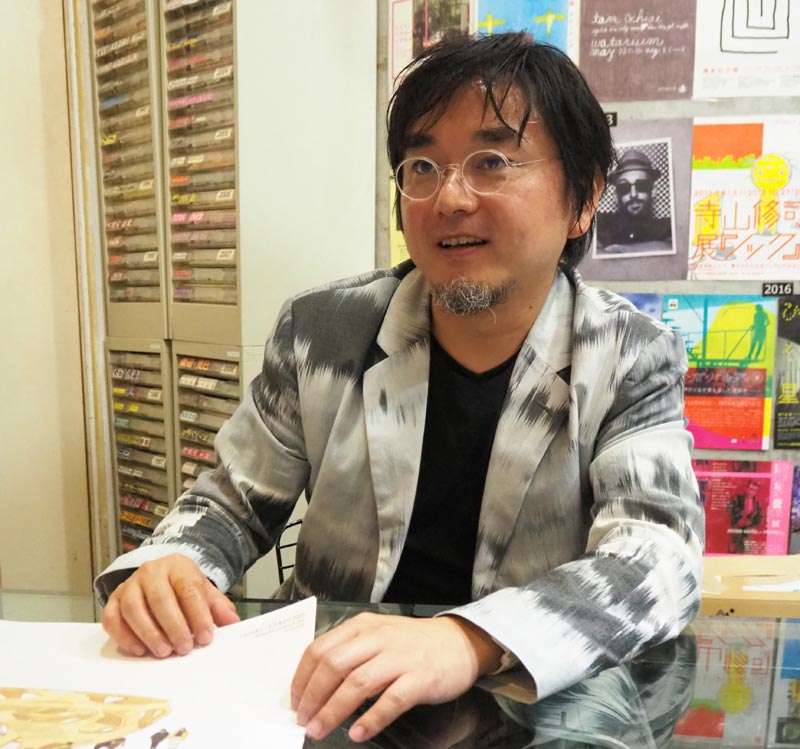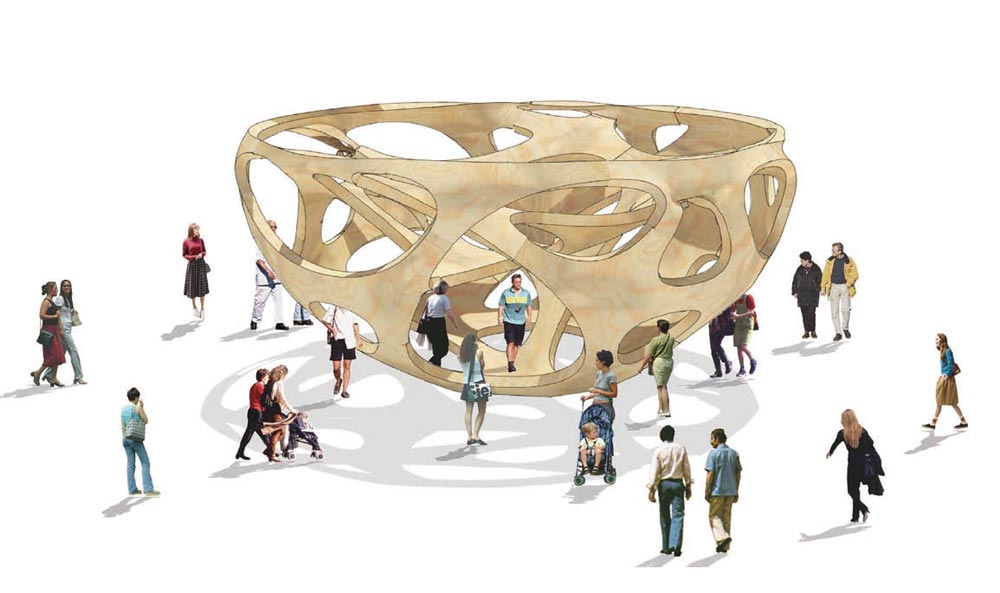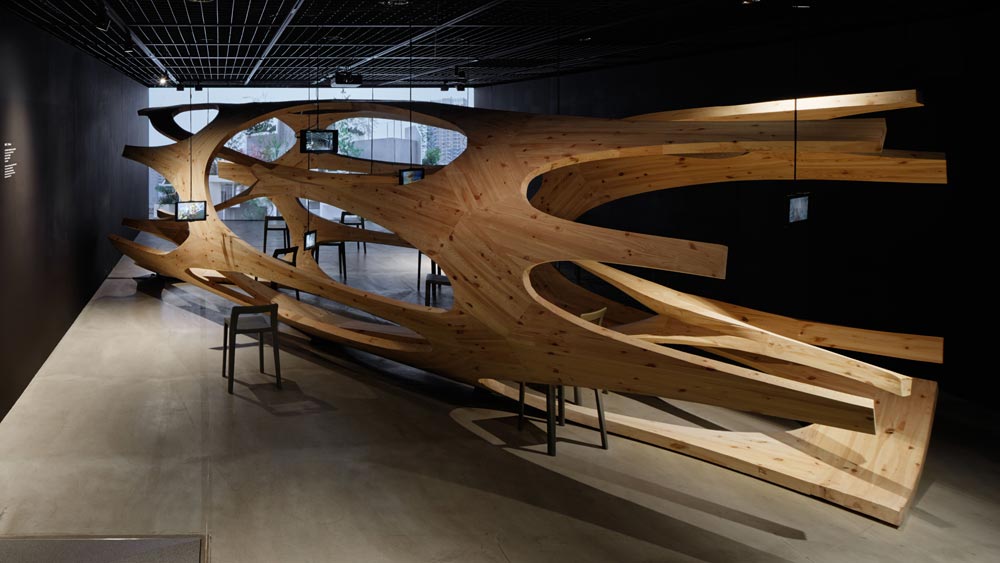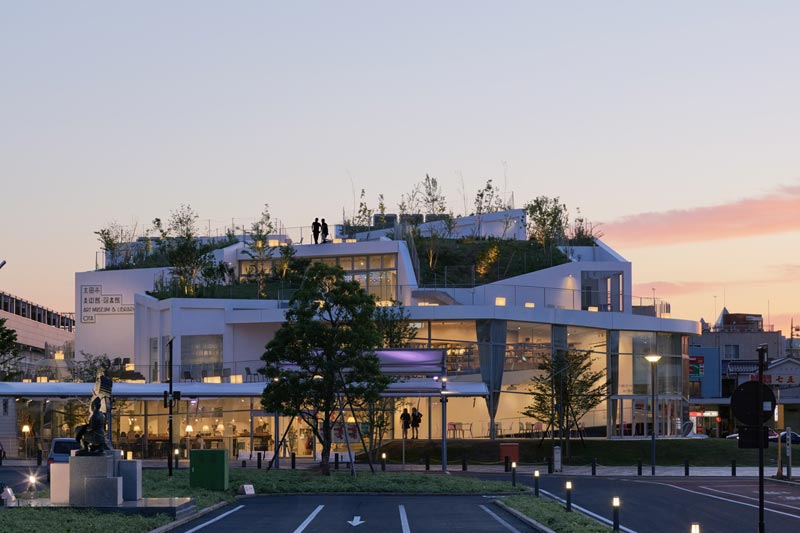Pavilion Tokyo 2020 Exhibitor Interview
1.Interview with Architect Akihisa Hirata (Part 1)
1.Interview with Architect Akihisa Hirata (Part 1)
2019/12/6
【Tokyo Tokyo FESTIVAL Special 13 is a cultural program co-organized by the Tokyo Metropolitan Government and the Arts Council Tokyo, Tokyo Metropolitan Foundation for History and Culture with the aim of promoting the 2020 Tokyo Olympics and Paralympics. Pavilion Tokyo 2020 (Executive Committee Directors: Kengo Kuma and Etsuko Watari) is one of the thirteen projects chosen in an open RFP which aims to shed light on world-acclaimed Japanese architecture. Seven exhibitors who are mostly young Japanese architects and artists will build small pavilions in the city of Tokyo. The exhibition will be held from June 6 to September 13, 2020.
On this occasion, we talked with one of the participating architects Akihisa Hirata, who is highly acclaimed for his remarkable achievements including the Art Museum Library Ota, which was his first major public commission that won him the 2018 Togo Murano Prize.】
On this occasion, we talked with one of the participating architects Akihisa Hirata, who is highly acclaimed for his remarkable achievements including the Art Museum Library Ota, which was his first major public commission that won him the 2018 Togo Murano Prize.】

―― What did you think when you heard about this program?
Hirata:
From what I know, many architects including Kenzo Tange were actively involved in the 1964 Tokyo Olympics. But this time I was somewhat disappointed by the fact that architects were not assigned any role to play in the 2020 Olympics, except for the New National Stadium. So, when I heard about this project from Etsuko Watari (Museum Director of the Watari Museum of Contemporary Art), I really sympathized with her ideas and felt honored to be invited to participate as an exhibitor.
From what I know, many architects including Kenzo Tange were actively involved in the 1964 Tokyo Olympics. But this time I was somewhat disappointed by the fact that architects were not assigned any role to play in the 2020 Olympics, except for the New National Stadium. So, when I heard about this project from Etsuko Watari (Museum Director of the Watari Museum of Contemporary Art), I really sympathized with her ideas and felt honored to be invited to participate as an exhibitor.
【Hirata's proposal is entitled "Global Bowl." It is a huge bowl-like structure in which the front and rear are interconnected in complex ways like the Klein Bottle. It will be located near a busy intersection where many people gather.】
―― It is such a fun shape. What is the inspiration behind it?
Hirata:
Many people come to Tokyo from all over the world for the 2020 Olympics. How can we transform such interactions into a scenery through architecture? Various people with different nationalities and skin colors and dressed differently come together at this particular spot for a moment in an extremely dense situation. I thought it would be interesting to create architecture that visually convey such exciting situations. One more thing, a stadium is often called a "bowl." The pavilion is much smaller in size than the stadium, but conversely, this extremely dense concentration of people and energy may be expressed more vividly in a small space like this. The hotchpotch situation of the Olympics and the mingling of different things may be captured through the eyes of visitors in this architecture.
Many people come to Tokyo from all over the world for the 2020 Olympics. How can we transform such interactions into a scenery through architecture? Various people with different nationalities and skin colors and dressed differently come together at this particular spot for a moment in an extremely dense situation. I thought it would be interesting to create architecture that visually convey such exciting situations. One more thing, a stadium is often called a "bowl." The pavilion is much smaller in size than the stadium, but conversely, this extremely dense concentration of people and energy may be expressed more vividly in a small space like this. The hotchpotch situation of the Olympics and the mingling of different things may be captured through the eyes of visitors in this architecture.

Global Bowl (Tentative title)
(Image courtesy of Arts Council Tokyo, Tokyo Metropolitan Foundation for History and Culture)
―― Can you go inside the pavilion?
Hirata:
Yes, we are planning to let people in. The pavilion is designed in such a way that people can walk around inside and use it like a bench to sit on. We even thought about letting people climb on some parts of it at first, but gave up the idea due to safety concerns.
Yes, we are planning to let people in. The pavilion is designed in such a way that people can walk around inside and use it like a bench to sit on. We even thought about letting people climb on some parts of it at first, but gave up the idea due to safety concerns.
―― How big is it going to be?
Hirata:
We are currently planning a structure that is 20m in diameter and 5m in height, but we might make it a little smaller and compact. We want to make a generous architecture incorporating surrounding trees and scenery, rather than something small and detail-oriented.
We are currently planning a structure that is 20m in diameter and 5m in height, but we might make it a little smaller and compact. We want to make a generous architecture incorporating surrounding trees and scenery, rather than something small and detail-oriented.
―― What materials are you thinking of using?
Hirata:
We are thinking of using wood. We are planning to make components using the three-dimensional cutting method and assemble them on site. I think people tend to associate wood with traditional architecture. In this pavilion, we want to show how technology, nature, and city can be integrated by building an organic form made of wood using the state-of-the-art technology of three-dimensional cutting. I think today's technology is advancing in such a way that actively incorporates nature and noise (foreign substances) and creates new forms by combining different substances. I am always thinking about ways to create architecture that is closer to nature and different from clear-cut architecture based on the 20th century engineering by using computers and combining miscellaneous elements. We intend to embody these ideas we are exploring on a daily basis in the form of a pavilion.
We are thinking of using wood. We are planning to make components using the three-dimensional cutting method and assemble them on site. I think people tend to associate wood with traditional architecture. In this pavilion, we want to show how technology, nature, and city can be integrated by building an organic form made of wood using the state-of-the-art technology of three-dimensional cutting. I think today's technology is advancing in such a way that actively incorporates nature and noise (foreign substances) and creates new forms by combining different substances. I am always thinking about ways to create architecture that is closer to nature and different from clear-cut architecture based on the 20th century engineering by using computers and combining miscellaneous elements. We intend to embody these ideas we are exploring on a daily basis in the form of a pavilion.
―― A mockup or a full scale partial model composed of wood parts made using the three-dimensional cutting method was installed in your solo exhibition at TOTO Gallery Ma in Tokyo ("Akihisa HIRATA, Discovering New" Exhibition, May 24–July 15, 2018).

"Akihisa HIRATA, Discovering New" Exhibition at TOTO Gallery Ma
©Nacása & Partners Inc.
Hirata:
Yes, it was relatively small in scale. This time, we are building a structure outside which we can actually use. We will use a similar system. The structure will be a structure by connecting networks using twisted geometry.
Yes, it was relatively small in scale. This time, we are building a structure outside which we can actually use. We will use a similar system. The structure will be a structure by connecting networks using twisted geometry.
―― At that time, you mentioned that the idea was inspired by the inner structure of the bone.
Hirata:
The bone has a cotton-like reinforcing structure inside, which becomes a network-like form when the residue is removed. Because wood is basically straight and strong in the axial direction, the direction of each component must be carefully adjusted toward the structurally strong direction in order to create a network-like knitted structure. We can create a strong wood structure by carefully controlling the cutting process and assembling three-dimensional components precisely.
The bone has a cotton-like reinforcing structure inside, which becomes a network-like form when the residue is removed. Because wood is basically straight and strong in the axial direction, the direction of each component must be carefully adjusted toward the structurally strong direction in order to create a network-like knitted structure. We can create a strong wood structure by carefully controlling the cutting process and assembling three-dimensional components precisely.
―― I learned that the three dimensional wood manufacturing method is highly advanced in countries like Switzerland and Germany. Can you use the three dimensional wood manufacturing method in Japan?
Hirata:
Yes, we can. We work with a company specializing in the development of wood structures. They are experts on the on-site assembly of components pre-cut in the factory. We had collaborated with this company to make the full-scale model exhibited at TOTO Gallery Ma and confirmed that we can make something larger than that. We are ready to take up a new challenge this time.
Yes, we can. We work with a company specializing in the development of wood structures. They are experts on the on-site assembly of components pre-cut in the factory. We had collaborated with this company to make the full-scale model exhibited at TOTO Gallery Ma and confirmed that we can make something larger than that. We are ready to take up a new challenge this time.
―― I have an impression that most of the buildings you have designed up until today are mostly made of materials other than wood.
Hirata:
We are concurrently working on the design development of the Yatsushiro Folk Theatre Tradition Center (tentative title) in Yatsushiro, Kumamoto Prefecture. It is a facility for preservation and future development of the Myoken Festival, which is a nationally designated important intangible cultural heritage. The building has undulated roofs made of local wood. We are using a state-of-the-art three-dimensional manufacturing method to build the roofs, which somewhat resemble roofs of traditional Japanese architecture including shrines and temples (this facility is scheduled to be completed in the spring of 2021.)
We are concurrently working on the design development of the Yatsushiro Folk Theatre Tradition Center (tentative title) in Yatsushiro, Kumamoto Prefecture. It is a facility for preservation and future development of the Myoken Festival, which is a nationally designated important intangible cultural heritage. The building has undulated roofs made of local wood. We are using a state-of-the-art three-dimensional manufacturing method to build the roofs, which somewhat resemble roofs of traditional Japanese architecture including shrines and temples (this facility is scheduled to be completed in the spring of 2021.)
【Pavilion Tokyo 2020 pavilions will be built within an approximately 3km-radius from the New National Stadium. Hirata's pavilion is planned to be located near an intersection where many people gather.】
―― Why do you want to build your pavilion near an intersection?
Hirata:
I think that the dynamics inherent to places like intersections generate vital energy in cities. For example, when I look at a busy intersection where many people come and go like rapidly moving particles, I feel vital energy like a force of nature, which is really invigorating.
I think that the dynamics inherent to places like intersections generate vital energy in cities. For example, when I look at a busy intersection where many people come and go like rapidly moving particles, I feel vital energy like a force of nature, which is really invigorating.
―― You are from the Kansai region. What do you think are the best characteristics of Tokyo?
Hirata:
I am particularly intrigued by the relationship between the city and its topography. Roughly speaking, the east side is flat and the west side is hilly and mountainous. During the Edo period, people started manipulating some parts of the ground by reclaiming and making embankments, and all sorts of buildings have been accumulated on the surface of the city after the modernization in Japan. Taking the Akasaka area as an example, buildings generally become taller as you go up to the higher ground, and its undulating topography is further emphasized as a result. If you change the viewpoint and see Tokyo from above, it is really fascinating to see a vast expanse of the complex and diverse landscape where natural topography and artefacts are intermixed. From an aesthetic point of view, there are many banal buildings, obviously, but from a crow's eye view, for example, it is probably a really fun and great city. What interests me is that something in Tokyo seems to awaken wild instincts of living creatures. Some people say that Tokyo has become homogeneous and boring, but I think Tokyo is more exciting than many other cities in the world, because you get to see traces of history and economic upheavals accumulated in strange ways there.
I am particularly intrigued by the relationship between the city and its topography. Roughly speaking, the east side is flat and the west side is hilly and mountainous. During the Edo period, people started manipulating some parts of the ground by reclaiming and making embankments, and all sorts of buildings have been accumulated on the surface of the city after the modernization in Japan. Taking the Akasaka area as an example, buildings generally become taller as you go up to the higher ground, and its undulating topography is further emphasized as a result. If you change the viewpoint and see Tokyo from above, it is really fascinating to see a vast expanse of the complex and diverse landscape where natural topography and artefacts are intermixed. From an aesthetic point of view, there are many banal buildings, obviously, but from a crow's eye view, for example, it is probably a really fun and great city. What interests me is that something in Tokyo seems to awaken wild instincts of living creatures. Some people say that Tokyo has become homogeneous and boring, but I think Tokyo is more exciting than many other cities in the world, because you get to see traces of history and economic upheavals accumulated in strange ways there.
―― Tokyo seen from a crow's eye view...
Hirata:
Perhaps a sense of pleasure I seek to achieve in architecture may be similar to a sensation crows experience in the city of Tokyo. They fly really close to the ground... I probably observe the city from an insect's or a bird's eye view. It is because insects were the only living creatures I was able to find in my childhood hometown. If I had grown up in a place where large-sized wild animals like tigers lived in close proximity, I may have developed a completely different point of view (laughs.)
Perhaps a sense of pleasure I seek to achieve in architecture may be similar to a sensation crows experience in the city of Tokyo. They fly really close to the ground... I probably observe the city from an insect's or a bird's eye view. It is because insects were the only living creatures I was able to find in my childhood hometown. If I had grown up in a place where large-sized wild animals like tigers lived in close proximity, I may have developed a completely different point of view (laughs.)
(Interview conducted and written by: Akiko Nagata, Editorial Board Member, Arts and Culture Section at the Mainichi Shimbun)
Archives
The second interview features architect Akihisa Hirata, who is highly acclaimed for his remarkable achievements including the Art Museum Library Ota, which was his first major public commission that won him the 2018 Togo Murano Prize. In this interview, Hirata talked about his ideas for the pavilion, the status of ongoing projects, his current interests and more.
In the second part of the interview, Hirata shared his ideas about the pavilion. His views on architecture gradually became clear as he explained ideas behind the Art Museum & Library Ota.



